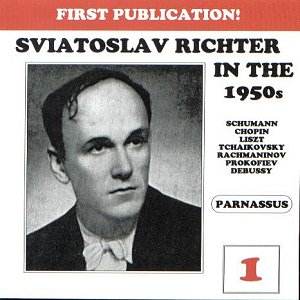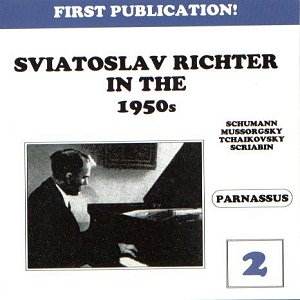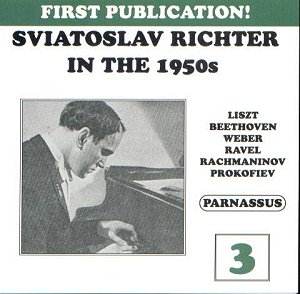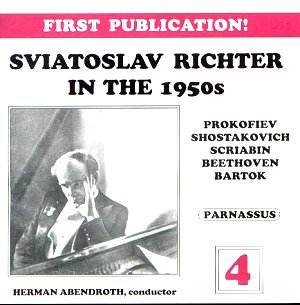This cache of Richter material from the 1950s
takes its significant place in the past decade’s worth of boxed
releases, single retrospectives and other unreleased items. Many
companies have rushed to issue such material. DG (singles and
doubles), Decca, EMI, Philips and Olympia amongst others have
had valuable contributions to make to the extensive Richter discography.
This has led to some confusion along the way. To these must be
added the notable existence of two large boxes from Melodiya and
Praga (Richter in Prague). The former collates discs made between
the late 1940s and the 1960s – live and studio recordings. The
latter is an even more extensive sweep, covering over thirty years
from the 1950s to the late 1980s. In terms of repertoire novelty
and breadth the Melodiya possibly wins on points but the Praga
is full of the most remarkable pianism, in generally better sound
(Melodiya’s brittle recording quality is sometimes an issue) though
when the Praga sound quality is poor it is really poor. Into the
lists comes Parnassus with these four slimline doubles – eight
discs, predominately featuring Richter in recital (the exceptions
are Concerti –Tchaikovsky in B flat minor and Beethoven C minor
with Rakhlin and Abendroth respectively).
There really are too many examples of Richter’s
untrammelled greatness to dwell on them in exhaustive detail.
Additionally though it will, I’m sure, read badly it will be helpful
to know which are items new to the current Richter discography,
so apologies in advance for the ensuing less-than-lucid prose.
Releases of this importance however deserve a degree of scrupulous
examination. The first disc collates two Moscow recitals of 1954
and 1958. All of these recitals were recorded there and the tapes
of these concerts were discovered in the early 1990s. Richter
programmed Quarrels from Prokofiev’s Cinderella, though less so
the other transcribed movements, which seems to make this a discographic
first. I say ‘seems’ because things are always changeable and
fluid when it comes to Richter on record. His 1958 Quarrels is
brittle, fractious and wonderfully characterised. The Autumn Fairy
is devilish and though there are some problems with the master
tape on Waltz, Cinderella and the Prince, the playing itself is
unquestionably vivid. He plays ten of the Visions fugitives. Six
and nine were favourites of long-standing. Other recorded evidence
exists but this is the most extensive concentration of the works
that we have. He recorded five of them for RCA in New York in
1960 (Nos. 6, 8, 9, 15 and 18). Whether fluent or limpid or full
of delicate tracery and mystery Richter lavishes exquisite care
on them. The Seventh Sonata that follows was taped shortly before
his Melodiya commercial LP of June 1958. It is believed to be
the only live performance in existence of the work that he premiered.
It shares many of the virtues of the commercial disc whilst adding
an even more concentrated sense of drama. The leonine power of
the Allegro inquieto, the utter clarity of its repeated figures,
the coiled bass are all of optimum strength. Allied to this the
austere relaxation into lyrical subjects is judged to perfection.
The sonata’s incipient lyricism emerges more concretely in the
Andante caloroso (a movement that for some doubtless unfathomable
reason I’ve always found bizarrely Elgarian) which Richter inflects
with intensely explosive drive in the faster section. The bristling
and striding Precipitato finale is, simply, unstoppable. The Schumann
Toccata is memorably heated but not inflexibly motoric with grand
gestures but is pipped to the post as the earliest extant example
by a Budapest performance that was once on AS. Clamorous applause
greets the shorter pieces – Debussy, Chopin, Rachmaninov. The
Chopin Etude Op. 10/3 was one that had featured in the famous
Sofia recital a couple of months previously. It appears again,
slower and less pressing in a companion performance four years
later, on the second CD in this set. The Rachmaninov is powerfully
driven. Debussy’s Cloches from Book II of Images is one of two
on this set. The other dates from a recital four years later and
they are both marvellous, the later one very slightly more measured.
Tchaikovsky’s Grand Sonata in G has never held much of a foothold
in the repertoire. The 1954 recital is the earlier of the two
Richter performances around (and it pre-empts the commercial LP
by a couple of years). It is full of powerful poetry and genuine
sensitivity. Coupled with it from that December 1954 recital come
a generous selection from Rachmaninov’s Preludes (Op. 23 and 32).
He recorded the same selection of Op. 32 six years later in New
York with the addition of No. 6. Of Op. 23 with which he was more
generally taken we already have an attractive selection to which
this acts as a splendid adjunct.
Volume Two dates from 1952, 1955 and 1957. We
start with Schumann. Like the more neurotic Horowitz, Richter
was a great Schumann player. There is some distortion/deterioration
on the tape initially but it gradually reduces. He did record
the Abegg Variations, in Rome and Venice in 1962, a performance
that has seen CD release but it’s good to have this performance,
notwithstanding the splintery sound that tends to fracture above
forte. The playing itself is frequently breathtaking as is the
case in the three Fantasiestücke from Op. 12. Aufschwung
is incendiary with an intensely motoric left hand, saturated with
Richter’s coruscating lyricism. Warum? catches the wandering
precision perfectly and Nicht Schnell is airborne in a
moment. The sound quality improves for Humoresque, which he was
to record for Melodiya the following year. I’ve not heard that
studio performance but it would be something if it matched the
swashbuckling dynamism, implacable bravura, rapt beauty and the
intimacy of this one. The 1952 recital gives us Scriabin’s Sixth
Sonata and Pictures at an Exhibition. He made a commercial recording
of the Sixth in June 1955. Here things are rather boxy acoustically
– but Richter conveys its saturnine intensities with almost pointillist
tracery and adamantine fire. Pictures at an Exhibition predates
that famous Sofia performance by five and a half years. Richter
starts with his accustomed briskness. His accents in the Ox Cart
are rather heavier than they were to become, the clogging diminuendo
at the close pictorial in its immediacy. Still, the hypnotic insistence
of Cum mortis in lingua mortua is as devastating as ever it was
to become. The pearl jewelled tone of the Ballet of the Chicks
is unmistakable, the alternating elegance and outburst of Tuileries
magnetic. Baba Yaga is more sharply etched rhythmically than later
and the accents are more vertiginous. The Great Gate starts much
cooler and quieter than Sofia. Here he doesn’t bathe in quite
so much pedal and whilst extremely colourful he is slower in 1952.
The tonal and expressive contrasts are more obviously romanticised
here. Tchaikovsky’s Concerto in B flat minor is conducted by the
volatile Nathan Rakhlin. Those who have Richter with Ancerl, Mravinsky,
Karajan – or even the Kondrashin (on Revelation) - won’t necessarily
race to throw away their discs. This is quite rawly recorded but
it is a most dramatic performance, with oases of reflective intimacy
in the first movement. The USSR State’s distinctive woodwind players
are to the fore and there are eloquently moulded string lines.
The exigencies of a live performance hint at the problems. The
flautist in the slow movement has his flat moments and Richter
makes a few minor fluffs along the way. I’d call them endearingly
inconsequential but then I remember how some of my colleagues
wage a Howard Hughes-like battle with the merest split note….
Richter and Rakhlin take what it’s most apposite to call a dramatically
measured approach to the finale and their collaboration is eminently
sympathetic.
The Third Volume again catches recitals a few
years apart – 1954 and 1958. The later recital contains rare gems.
Of the Liszt works only one - Aux cyprès de la Villa
d’Este – exists in any other form. None was commercially recorded,
as far as I’m aware. Vallée d’Obermann is a memorable
performance, magisterial, conveyed through entirely musical means,
with a devastatingly virtuosic conclusion that plainly stuns the
audience. My only complaint is that the sound, whilst good, accentuates
a slight tendency to clangour. It’s unfortunate that the audience
were in such bronchial form during La Sposalizio but they receive
a suitably intense performance. The pieces from Années
de Pèlerinage were the only ones Richter played but they
didn’t stay too long in his active repertoire so we should be
grateful that they are here and in such decent sound. Richter
never played a cycle of Beethoven’s Sonatas – he limited himself
to twenty-two of the canon. He recorded the Pathétique
in 1959 and this Parnassus performance, a year earlier, is the
only known live example in existence. He achieves a real balance
between reflection and assertion in the first movement, his rubati
being marked but not extreme, his playing incisive and commanding.
Sometimes in the slow movement I wondered at his intensely staccato
phrasing – and this is reserved phrasing, patrician but relatively
aloof – but the rondo finale is excellently carried off. The recital
from December 1954 shares some of the repertoire and musical imperatives
of those captured by Praga in their box – a case in point is their
May 1954 Weber Sonata in D minor. Here we have the same sonata
a few months later, in December of that year and it’s again a
case of Richter taking a piece by the scruff of its neck and breathing
lordly life into it. This three movement sonata might not be seen
ostensibly to bear the weight of Richter’s touch in the opening
Allegro feroce but he really makes it come alive, the slow movement
too and he is lissom in the finale. The Ravel selection is often
plain staggering. Not only do we have the only known Le Gibet
from Gaspard but we have a spectacular Alborada, an infinitely
languorous Pavane, a glinting, glittering, mercurial Jeux d’eau
and the urbane virtuosity of his Valse nobles et sentimentales.
The first disc in the fourth volume is given
over to Prokofiev, Shostakovich and Scriabin. The Prokofiev is
the Ninth Sonata, dedicated to and first performed by Richter.
This September 1956 performance shortly precedes that on Praga.
The commercial LP followed a couple of years later and only a
1980 Tokyo recital is known to have survived of his other performances
of it (that can be found on Memoria). Doubly valuable is that
the second disc contains an equally powerful performance of the
Sixth Sonata from the following month. The powerful attack and
variegated colours are striking, imperishably alive here. Another
performance is preserved from a Prague recital, there is the commercial
New York LP and a miscellany of others (Leningrad, Locarno and
Tokyo amongst them). Richter actually recorded a selection of
Shostakovich’s Preludes and Fugues in the Domovina Studios in
Prague, in November 1956, a couple of years before the composer
recorded his immensely moving but technically sometimes shaky
performances of his selection. When he was in Paris Richter
added another selection in 1963 and whilst he did record individually
another couple he never set down anything like the cycle – maybe
around half. There are some splutterers audible in the doubtless
cold audience in Moscow in 1958 but nothing intrudes on Richter’s
grandeur and dynamism. He exudes a leonine power in the Prelude
of No. 3, and increasing drama in No. 6’s Prelude as well as real
delicacy in its Fugue. He conjures up elfin whispers in the Prelude
of No. 7 in A, beautiful voicings in its Fugue and demonstrates
dramatically fast fingers in the Prelude of No. 2. Throughout
the whole of that in F minor he is withdrawn and elliptical and
in the D flat Prelude (No. 15) he is portentous, wilful, mocking,
securing an elfin, very much on its toes, middle section. Even
that didn’t prepare me for the almost manic violence of Richter’s
Fugue in D flat.
The final disc also includes a reading of Beethoven’s
C minor Concerto conducted by Abendroth. Commercial discs with
Sanderling (1962) and Muti (1977) do exist, backed up by live
performances with Rowicki, Bakala, Ancerl and Kondrashin. This
was the only time Richter worked with Abendroth and is a fine
performance somewhat vitiated by sour-ish wind tuning in the first
movement. Abendroth is scrupulous about a heavy bass line – highly
emphatic – and Richter is on his accustomed fine form though when
he comes to the first movement cadenza he simply blazes away,
his left hand very heavily italicised, overpowering the right
with some splashes. This is Simon Barere time and not for me.
In the slow movement I found some of Richter’s phrasing just a
little unsettled but the finale is energetic and good. Not otherwise
overly recommendable however. The Bartók Peasant Songs
weren’t to be commercially recorded until 1972 in Moscow so this
is a good opportunity to hear them in crypto-embryonic form –
melancholy, flighty, stern, dancing, deliciously lilting, a cornucopia
of life and colour.
It’s been an exhilarating experience listening
to these eight discs of previously unreleased Richter in Moscow.
There are, as I’ve noted, some audio problems and it’s in general
the case that the sound is rarely "comfortable." Against
that – and it’s such a minute price to pay - comes the immense
rarity of much of the music, the sense too of even greater reserves
of fire and power in his playing, the fresh, sometimes overpowering
drive and serenity he was capable of imparting. Parnassus haven’t
gone in for particularly fancy or extensive notes – plain, to
the point, but presenting the music as the focus of the life-force
that Richter generated whenever he appeared.
Jonathan Woolf



